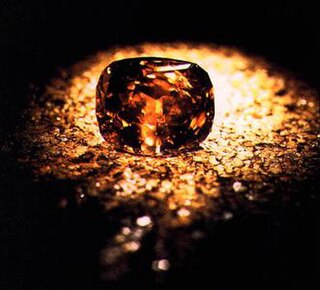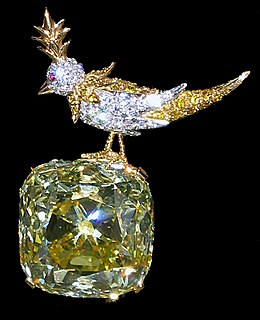 W
WThe Allnatt Diamond is a diamond measuring 101.29 carats with a cushion cut, rated in color as Fancy Vivid Yellow by the Gemological Institute of America. This diamond is named after one of its holders, Major Alfred Ernest Allnatt, a soldier, sportsman, art patron and benefactor.
 W
WThe Cullinan Diamond was the largest gem-quality rough diamond ever found, weighing 3,106.75 carats (621.35 g), discovered at the Premier No.2 mine in Cullinan, South Africa, on 26 January 1905. It was named after Thomas Cullinan, the mine's chairman. In April 1905, it was put on sale in London, but despite considerable interest, it was still unsold after two years. In 1907, the Transvaal Colony government bought the Cullinan and then presented it to Edward VII, King of the United Kingdom, who had it cut by Joseph Asscher & Co. in Amsterdam.
 W
WThe Eureka Diamond was the first diamond discovered in South Africa. It originally weighed 21.25 carats (4.250 g), and was later cut to a 10.73-carat (2.146 g) cushion-shaped brilliant, which is currently on display at the Mine Museum in Kimberley. The discovery of diamonds in South Africa led to the Kimberley Diamond Rush, and marked the beginning of the Mineral Revolution.
 W
WThe Excelsior Diamond is a gem-quality diamond, and was the largest known diamond in the world from the time of its discovery in 1893 until 1905, when the larger Cullinan Diamond was found. It was found on June 30, 1893 at the Jagersfontein Mine in South Africa, 130 kilometres south east of Kimberley whose fame as a diamond mining center always overshadowed that of Jagersfontein. It had a blue-white tint and weighed 971 old carats or 995.2 metric carats. The Excelsior rates as the fourth largest rough diamond of gem quality ever found. It was ultimately cut into ten stones weighing from 13 to 68 carats..
 W
WThe Golden Eye Diamond is a flawless 43.51-carat (8.702 g) Fancy Intense Yellow diamond, claimed by one of its past owners to be the world's largest of its cut and color. It is believed to come from the Kimberley area of South Africa. Tom Moses, a senior vice president with the Gemological Institute of America, agrees that it came from South Africa, but it has not been able to be determined the mine of origin.
 W
WThe Golden Jubilee Diamond, a 545.67 carat brown diamond, is the largest cut and faceted diamond in the world. It outweighs the Cullinan I by 15.37 carats. The Golden Jubilee Diamond was discovered in the Premier Mine, which is also the origin of the Cullinan diamond (1905) and other notables such as the Taylor–Burton (1966) and the Centenary (1986). Cullinan I, also known as the Great Star of Africa, had held the title of the largest cut and faceted diamond since 1908.
 W
WThe Jubilee Diamond, originally known as the Reitz Diamond is a colourless, cushion-shaped diamond weighing 245.35 carats, making it the sixth largest diamond in the world. It was originally named after Francis William Reitz, the then president of the Orange Free State where the stone was discovered, before being renamed to honour the 60th anniversary of the coronation of Queen Victoria in 1897.
 W
WThe Oppenheimer Diamond, a nearly perfectly formed 253.7 carats (50.74 g) yellow diamond crystal, is one of the largest uncut diamonds in the world, and measures approximately 20 × 20 millimeters. It was discovered in the Dutoitspan Mine, Kimberley, South Africa, in 1964. Harry Winston acquired the stone and presented it to the Smithsonian Institution in memory of Sir Ernest Oppenheimer.
 W
WThe Portuguese Diamond is a large octagonal-cut diamond known for its flawlessness and clarity. It weighs 127.01 carats (25.402 g).
 W
WThe Premier Rose Diamond was one of the large rare gems produced by Premier Mine, of De Beers in South Africa.
 W
WThe Tiffany Yellow Diamond is one of the largest yellow diamonds ever discovered. Its carat weight was originally 287.42 carats in the rough when discovered in 1878 in the Kimberley mine in South Africa. It was cut into a cushion shape of 128.54 carats with 82 facets—24 more than a traditional round brilliant—to maximize its brilliance. The facet pattern features eight needle-like facets pointing outward from the culet (bottom) facet. Jewelry and diamond historian Herbert Tillander refers to this as a "stellar brilliant cut", and lists the gem in his book, Diamond Cuts in Historic Jewelry – 1381 to 1910 (1995), among other such diamonds: the Cullinan Diamond, the Koh-i-Noor, the Polar Star, the Wittelsbach, and others.